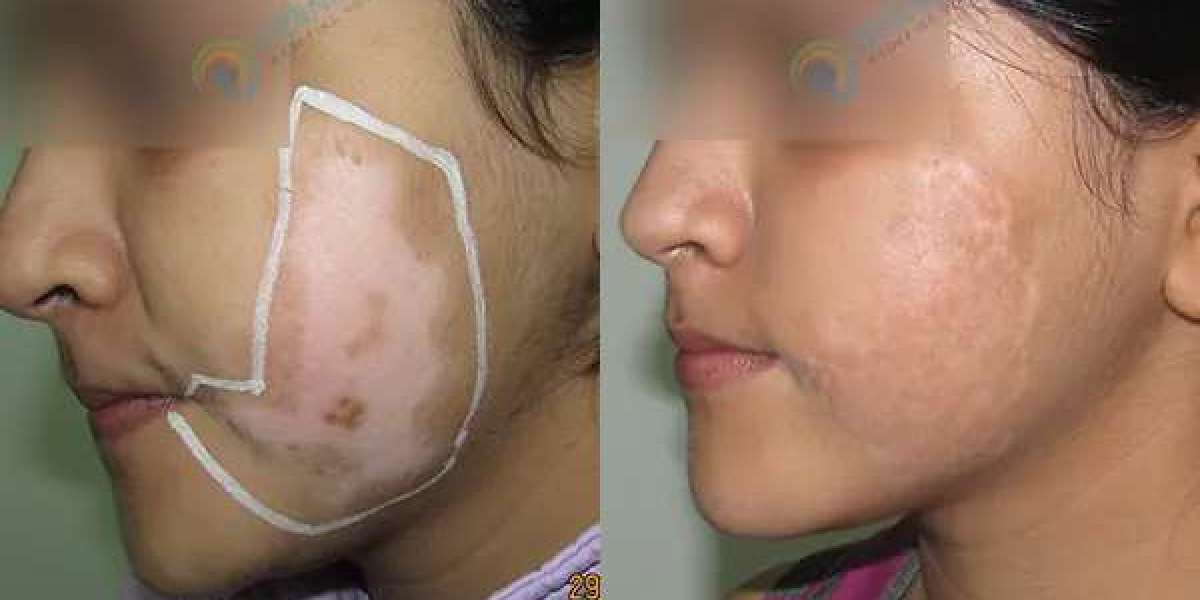Vitiligo is a skin condition that affects at least six million people worldwide. It is characterized by skin depigmentation, leading to the development of white patches on different body parts. Understanding vitiligo is crucial not only for those affected but also for individuals who have friends or loved ones with the condition. This blog will explore the essential aspects of vitiligo, including its causes, symptoms, types, and the best vitiligo treatment in Delhi.
Vitiligo Causes
Leading skin doctors in Delhi state that the exact cause of vitiligo is unknown; however, several potential triggers have been identified. One of the most apparent causes is an autoimmune response, where the body's immune system mistakenly attacks its melanocyte cells, which are responsible for producing melanin (skin pigment). This results in depigmentation and white patches on the skin.
Genetic and Hereditary Factors
Hereditary predisposition plays a significant role in vitiligo. Research indicates that individuals with a family history of vitiligo or other autoimmune diseases have a higher risk of developing the condition. Studies have shown that Caucasian vitiligo patients are significantly more likely to develop autoimmune thyroid disease than those without vitiligo, implying that genetic factors may contribute to the disease's development.
Environmental Triggers
Dermatologists in Delhi have also linked certain environmental factors to the onset of vitiligo. These include:
Severe Sunburn – Excessive exposure to UV rays can damage melanocytes, leading to the development of vitiligo patches.
Industrial Chemicals – Exposure to certain chemicals, such as phenolic compounds, can trigger oxidative stress, which destroys melanocytes.
High-Stress Levels – Chronic stress can weaken the immune system, contributing to vitiligo onset or progression.
Symptoms of Vitiligo
Early diagnosis of vitiligo is essential for timely treatment. The most noticeable symptom is the appearance of white patches on the skin. These patches can occur anywhere on the body but are most commonly found on areas exposed to the sun, such as the face, neck, hands, and arms. The patches may start as small spots and gradually increase in size.
Other Symptoms of Vitiligo:
Premature Graying of Hair – Vitiligo can affect melanocytes in hair follicles, causing premature graying of the scalp, eyebrows, eyelashes, and beard.
Retinal Pigmentation Disturbance – Some individuals may experience changes in the color of the inner layer of the eye (retina), although this typically does not affect vision.
Mucosal Depigmentation – In some cases, vitiligo can cause loss of pigmentation in the lips, mouth, and genital areas.
Psychological Impact of Vitiligo
Beyond physical symptoms, vitiligo can have a significant emotional and psychological impact. Many individuals experience low self-esteem, anxiety, and social withdrawal due to their appearance. Seeking support from dermatologists, mental health professionals, or vitiligo support groups can help individuals cope with the emotional aspects of the condition. If you are looking for laser hair removal in Delhi, then Dermalife is only one of the place.
Types of Vitiligo
Vitiligo is classified into different types based on the distribution of depigmented areas. Understanding these types helps in diagnosis and treatment planning.
1. Generalized Vitiligo
This is the most common type, where white patches appear randomly on various body parts. These patches are often symmetrical and may be present on both sides of the body.
2. Segmental Vitiligo
This type is limited to one area or side of the body. It typically starts at a younger age and remains active for a few years before stabilizing. Early treatment can improve outcomes.
3. Focal Vitiligo
Focal vitiligo is a rare form where small, isolated patches appear in one specific area of the body. It does not spread as widely as other types.
4. Mucosal Vitiligo
This type affects mucous membranes such as the lips, mouth, and genital areas. It may require specialized treatment due to its location.
5. Trichrome Vitiligo
In this form, depigmented patches are surrounded by areas of lighter pigmentation, creating a tricolor effect. It is considered more challenging to treat due to varied pigment distribution.
6. Universal Vitiligo
Universal vitiligo is the most severe form, where more than 80% of the skin loses pigmentation. Managing this condition requires extensive treatment and care.
Best Vitiligo Treatment in Delhi
Vitiligo management focuses on halting disease progression and restoring pigmentation. The best dermatologists in Delhi, including Dr. Gaurav Garg at Dermalife, offer advanced treatments for vitiligo.
Treatment Options for Vitiligo
Topical Medications
Corticosteroids and calcineurin inhibitors help reduce inflammation and promote repigmentation.
Phototherapy (PUVA and NB-UVB)
Narrowband ultraviolet B (NB-UVB) therapy is a widely used treatment that stimulates melanocyte activity, leading to repigmentation.
PUVA (Psoralen + UVA) therapy involves using psoralen medication followed by UVA light exposure.
Excimer Laser Therapy
This treatment delivers targeted UVB light to affected areas, promoting pigment restoration without affecting surrounding skin.
Surgical Treatments
Melanocyte Transplantation: Healthy melanocytes from the patient’s skin are transplanted to depigmented areas.
Skin Grafting: Small sections of pigmented skin are transferred to vitiligo-affected areas.
Depigmentation Therapy
For patients with widespread vitiligo, depigmentation therapy lightens the remaining pigmented skin to achieve an even tone.
Lifestyle and Dietary Management
A diet rich in antioxidants, vitamins (B12, C, D), and minerals (zinc, copper) may help improve skin health.
Avoiding triggers such as stress, harsh chemicals, and excessive sun exposure can prevent flare-ups.
Why Choose Dr. Gaurav Garg at Dermalife?
If you are searching for the best vitiligo treatment in Delhi, Dr. Gaurav Garg at Dermalife is a top-rated specialist known for his expertise in advanced vitiligo therapies. With years of experience and cutting-edge treatment options, Dermalife provides customized solutions to help patients regain their confidence and skin health.
Conclusion
Vitiligo is a complex skin condition with multiple causes, symptoms, and subtypes. Understanding its triggers and early signs can aid in prompt diagnosis and treatment. While vitiligo can affect one's self-esteem, effective treatments are available to manage the condition and restore skin pigmentation.
For expert guidance and advanced vitiligo treatment in Delhi, consult Dr. Gaurav Garg at Dermalife today. With the right approach, individuals with vitiligo can lead confident and fulfilling lives.








